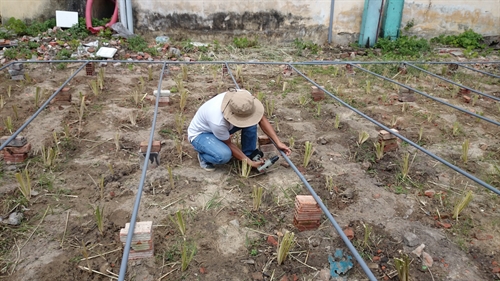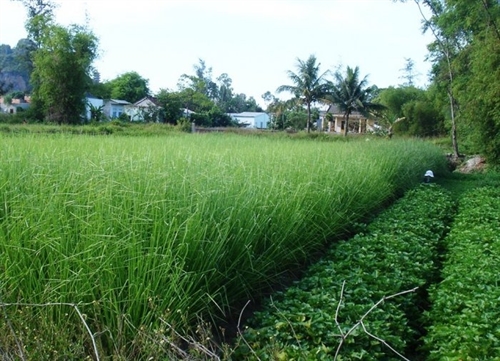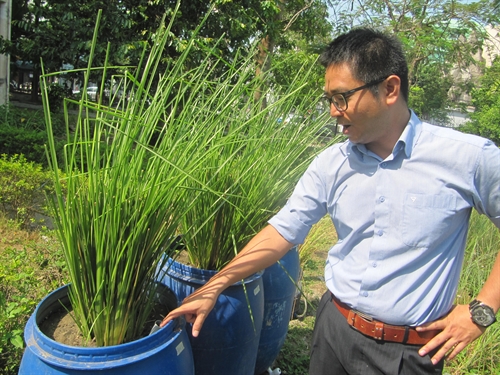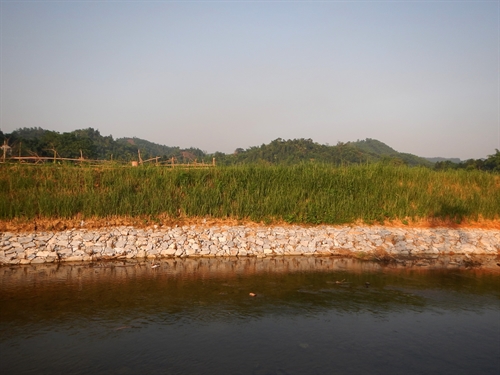 Sunday/Weekend
Sunday/Weekend

After persuading the managing board of Đà Nẵng Technology College, lecturer Trần Minh Thảo set up the first toxic sewage treatment project for the school’s laboratory building. And now he's offering a green solution to the country's pollution woes. Công Thành reports.
 |
| New method: Mountain roadsides in Đà Nẵng need protection from erosion and landslides. The city has developed a vetiver grass system to replace concrete walls used for this purpose. |
By Công Thành
After persuading the managing board of Đà Nẵng Technology College, lecturer Trần Minh Thảo set up the first toxic sewage treatment project for the school’s laboratory building.
It is a vetiver (Vetiveria Zizanioides) grass system – the first-ever biological sewage treatment model in Đà Nẵng that uses grass to treat sewage.
The project is a 200sq.m garden with 5,000 vetiver grass bushes, which filter 10 cubic metres of toxic sewage from the laboratory, releasing safe waste water into the environment each day.
“It’s amazing,” Thảo said. “We measured that over 90 per cent of heavy metals contained in the sewage dissolved in the process. Heavy metal levels in the sewage water met safety standard of waste water for Việt Nam.”
He said continuous tests of the grass system were carried out daily over the past two years.
“Not many plants and normal grass species could grow in the poisonous, contaminated sewage and soil, but vetiver grass could exist in the toxic habitat and reduce the contamination,” he said. “We tested that the grass could clear arsenic and cyanide – the two most poisonous chemicals. It’s an easy and quick solution against polluted environment in context of a lack of pollution treatment funding in Việt Nam.”
Thảo estimated that it costs VNĐ7 million to chemically treat one cubic metre of waste water at Khánh Sơn Dump, while vetiver grass garden would require just VNĐ1 million to do the same thing.
He said his research revealed the importance of the grass’s roots in cleaning toxic chemicals. It acted as a filter
He said a root can grow 10 times as long as it sprouts, from 5cm to 70cm after one month. Thảo said he even watered the vetiver grass with water from the dump.
The 39-year-old lecturer said he was preparing for a treatment project at Khánh Sơn Dump – the biggest of its kind in Đà Nẵng.
He said the vetiver grass treatment project could clean 500 cubic metres of water from the dump per day.
According to Phan Thị Nữ from Đà Nẵng urban environment company, the city discharged nearly 700 tonnes of waste each day.
"The city reserves an annual fund of VNĐ7 billion (US$333,000) for waste collection and treatment, but it could not solve the problem of pollution from dumps, as the city’s garbage is still buried or burned at dumps,” Nữ said.
The 48.3ha dump has polluted underground water and the environment in suburban areas.
She said a vetiver grass system could be an option for cleaning the area around the dump, along with the development of a garbage treatment plant to recycle plastic and other solid waste.
Desalinisation
Vetiver grass was also used in a desalinisation project for 250ha of farmland in Cẩm Thanh Commune on the Thu Bồn River in Hội An.
The farm, which was affected by high salinity due to rising sea levels, has not been used for gardening in recent years.
Nguyễn Tố Quyên, a member of the project, said the grass would be installed as a “green dyke” to protect land from becoming saline.
“The grass fence would help recover from 30 to 60 per cent of saline land in the area, while it would prevent mouse or snakes from approaching due to its scent,” Quyên said.
Research on vetiver grass has showed that its leaves could kill 90 per cent of young mammal pests.
Quyên said another vetiver grass project had been created to recover a large area of impoverished farmland in the Central Highlands’ Kon Tum Province.
Sa Thầy District in the province has nearly 34,000ha of infertile rice farmland – 75 per cent of the district’s farming area – due to erosion and overuse of chemical fertilisers and pesticides.
She said farmers in the district would restore soil fertility within six months to a year of growing vetiver grass.
Green anchor
In 2001 and 2003, the Ministry of Agriculture and Rural Development and Ministry of Transportation allowed the use of vetiver in disaster mitigation and infrastructure protection. A slope of 3,000km on the Hồ Chí Minh Trail, river banks and sea dyke in An Giang, Quảng Ngãi and Nam Định provinces benefited from the grass.
Bùi Thanh Bình, an engineer working on the Hồ Chí Minh Trail said the grass helped stabilise the surface of sloping terraces.
“We had to cast concrete in protection of the upper part of the roadside in mountainous areas that the Hồ Chí Minh Trail run through. However, concrete dyke protection sometimes could not prevent erosion and landslides in the rainy season,” Bình said.
La Văn Hiếu of the Đà Nẵng-based Construction Advanced Technology Limited company (SBTV) explained that the grass root can grow 3m deep within the first year. Then it acts as an anchor to prevent soil on the slope from being washed out during the rainy season.
“Many sloping mountain roadsides along the Hồ Chí Minh Trail and mountain resorts in Huế, Đà Nẵng, Quảng Nam and Đắk Lắk were protected by green cover of vetiver grass,” Hiếu said. "A square metre of vetiver in protection of upper roadsides costs only VNĐ100,000 (US$4.70). Meanwhile, one square metre of concrete wall costs VNĐ700,000 ($33).
"From 2011 onwards, we had grown vetiver on 4,000sq.m of sloping land on Sơn Trà Mountain and a section of roadside along Bà Nà Mountain to prevent landslides during the rainy season. When the powerful Nari Storm hit in 2013, the green vetiver layer kept the road wall stable.”
Hiếu said his company, which is a member of the Việt Nam Vetiver Network recognised by Vetiver Network International, developed a 5ha vetiver nursery in Hòa Nhơn Commune in Đà Nẵng to provide saplings for protecting roadside slopes and mountainsides in Việt Nam.
According to Thảo, vetiver grass could feed cattle or compost in farming.
Thảo said vetiver grass could help clean and recycle water at aquaculture farms, or treat waste at livestock farms.
Many functions
Trần Tân Văn, director of the Việt Nam Institute of Geo-sciences and Mineral Resources and Director of the Việt Nam Vetiver Network, said vetiver has been planted in more than 40 provinces and cities to mitigate a spate of environmental problems.
He said many scientific reports presented at the sixth International Vetiver Conference in Việt Nam last year focused on the importance of vetiver in different ranges with water and soil pollution, desertification, climate change and disaster mitigation, as well as prevention of erosion and stabilising river banks and sea dykes.
“The grass has been used to protect highway dykes, cover waste dumps near coal mines, and on dioxin-contaminated soil in some provinces in Việt Nam,” Văn said. "It’s a mass solution for the worst environment pollution and for protecting infrastructure projects and beaches from erosion.”
A survey on vetiver use for dioxin contamination has been implemented at Biên Hòa Airport, but the research hasn’t been completed yet.
Văn added that the grass can be used to reduce greenhouse gas emissions to fight climate change.
The geologist said Việt Nam has yet to process the grass as a material for crafts, textiles and oil production, or as vetiver-made textile products and souvenirs from Thailand and India.
Trần Văn Mẫn of Đà Nẵng’s Planning and Investment Department said the grass has been planted on the Cổ Cò River’s banks.
Mẫn, who is the Việt Nam Vetiver Network Co-ordinator, said developing the use of vetiver grass was necessary.
Vetiver grass has been developed by the World Bank (WB) for the purpose of soil protection and water resources for agriculture since the 1980s. In the past 20 years, vetiver grass has been grown in more than 100 tropical and subtropical countries in Ocenia, Asia, Afica and Latin America to treat waste water (both household and industrial) and waste matter in mining areas or contaminated areas.
Thảo said the grass would help Đà Nẵng deal with waste treatment and pollution at industrial zones to fulfill the city’s target of becoming a ‘green city’ by 2025. VNS
 |
| Coming clean: A vetiver grass system is set up to treat waste water at Đà Nẵng Technology College. The grass has been an effective solution to deal with poisonous sewage. |
 |
| Fields of green: Vetiver grass grows at a nursery centre in Hòa Nhơn commune in Đà Nẵng city. |
 |
| Fortified: Vetiver grass is planted on a sloppy mountain road side along Hồ Chí Minh Trails. |
 |
| Grass guy: Dr.Trần Minh Thảo takes care of a pot of vetiver (Vetiveria Zizanioides) grass at a garden of Đà Nẵng city’s Technology College. He built up the first toxic sewage treatment project for his college’s laboratory. VNS Photos Công Thành |
 |
| Laying waste to waste: Vetiver grass is grown to protect a river bank section in Thừa Thiên-Huế Province. |




